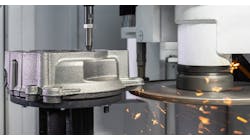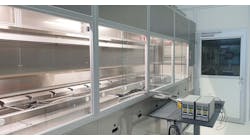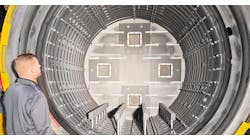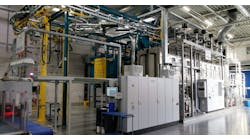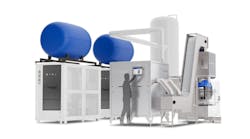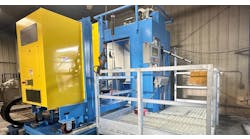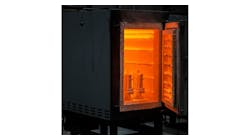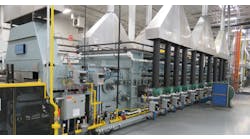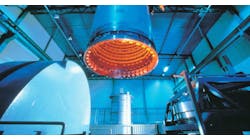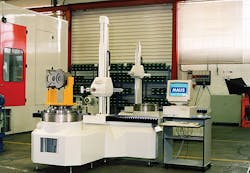Automatic grinding equipment is quickly becoming one of the foundry industry’s hottest and most productive tools to automate, reduce costs, and streamline production, but many foundries are challenged by the task of programming of the machine to meet their needs. The technology is becoming faster, more efficient and more user-friendly, but as the foundry industry at-large makes the transition from low-tech processes to high-speed, high-technology “systems,” some increasingly complex issues are emerging:
1. The ability to find, train, and retain the employees with the skills to program the automatic grinding equipment.
2. The need to stop the automatic grinding machine and operation in order to program new parts.
How does a reliable worker with 10 to 20 (or more) years of foundry industry experience, and skills that now qualify as “low tech,” learn to use the unfamiliar, higher-tech machines — while the business maintains its production goals and meets rising standards for product quality?
There are two types of automatic grinding machines available to the market and each can work quite effectively for a foundry if it has the right skills available, in the workforce or from the local labor pool. A robotic grinding system is trendy, productive, and very versatile because it can replicate the movement of an employee’s hand, but it requires more highly skilled workers to program it, and to operate and maintain the equipment. It calls for a programmer that has knowledge of the specific robot that is used (ABB Robotics, Fanuc, Kuka, Motoman, etc.), and the programming, which may demand two to six hours of focused work inside the machine while the grinding operation is shut down, bringing productivity to a halt.
Robotic grinding also requires a maintenance technician who is well versed in robotic service. Most foundries do not currently employ people with these skills, nor are they are located in areas where people with these skills are readily available, or economically feasible, if the foundry must compete with high-tech-industry wages for those services.
The alternative solution involves CNC programming, which continues to be a solid standby technology for most North American foundry operations. CNC is a productive, reliable, faster approach to high productivity control technology, and it is much easier to find qualified employees to program, operate and maintain it because the general workforce has been exposed to CNC systems for several decades, and to computers for at least the past 15 years. This means there is a greater pool of potential programmers, operators, and maintenance technicians for these machines.
Note that many automated CNC grinding systems also require that production should stop for anywhere from two to six hours in order to set up and program production for a new part.
Palmer Maus North America offers a CNC automatic grinding platform that allows foundry workers to program parts with off-line technology while the production continues. This CNC comes with a compact, off-line programming bench that can be set in an isolated office or lab, which is more conducive to the concentration requirements of programming. The programming bench has a pedestal to place the fixture holding the finished casting, an arm that holds the simulated grinding tools, and a place to hook up a computer.
The proprietary software allows the programmer/operator to take the arm holding the tool to the area on the casting where grinding is desired and, while the tool is moved from point to point, the computer collects (i.e., downloads) each grinding location point to the program. When this is completed (usually a one to three hour process), the programmer simply places a thumb drive into the computer, downloads the program, takes the thumb drive to the CNC machine, installs the program to the machine, runs one or two castings to make adjustments, and saves the program to the machine.
The program also can be saved to the company server as a backup system. The relatively simple process is easy for most employees to learn, assuming that he or she possesses a very basic understanding of computers. More than that, this simplicity expands the pool of qualified employees.
Keeping Investments Working
Also, it will not tie up the machine during programming: It allows the foundry’s investment in automatic grinding equipment to continue working as a productive and profitable grinding machine versus a non-productive programming machine.
This ability to program off-line not only allows the foundry to maximize production, but it allows for a very quick changeover of parts (usually 5-15 minutes.) The quick changeover capability makes CNC automatic grinding suitable for both high-production and job-shop operations. It provides an entirely new level of versatility to automatic grinding.
This off-line programming innovation solves both of the critical issues mentioned earlier in this article. It simplifies the programming process in a manner that widens the potential employee base in regards to necessary skills, while eliminating the need to stop production for hours in order to program the machine. Since most of the current workforce has grown up operating computers from a very young age and a large percentage of the workforce has some experience with CNC equipment, it becomes easier to find qualified operators, programmers and maintenance technicians for this equipment.
Automatic grinding technology continues to evolve in the foundry industry. With the off-line programming capability CNC automatic grinding can meet the diverse needs of both the high production and job shop foundry markets. Companies like Palmer Maus North America are dedicated to offering complete grinding solutions for their customer base. They are constantly searching for ways to improve the technology and make it faster, more efficient and user-friendly for the foundry. The off-line programming bench is just one of the many innovations created to achieve that goal.
Tim Butler is sales director for Palmer Maus North America. Visit www.palmermaus.com
